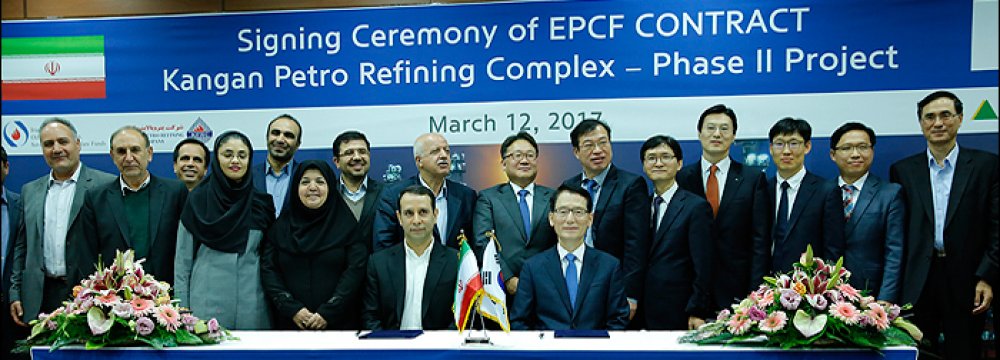South Korea's Hyundai Engineering Co. (HEC) signed an agreement on Sunday for financing and constructing the second phase of Kangan Petro Refining Complex -- a major petrochemical and refinery project in southern Bushehr Province.
The engineering, procurement, construction and financing (EPCF) agreement, worth €3 billion ($3.2 billion), was signed in Tehran by the HEC and Ahdaf Investment Co., the majority stakeholder in the Kangan project. Ahdaf is a subsidiary of Iran's Oil Pension Fund Investment Co., Shana reported.
As per the agreement, 95% of the funds will be provided by Hyundai through South Korean financial institutions, according to Asghar Arefi, the chief executive of Ahdaf.
"Financing will begin in nine months," Arefi said, adding that the complex is expected to become operational in four years.
The complex is set to receive natural gas from Phase 12 of the South Pars field in the Persian Gulf for producing 400,000 tons of heavy polyethylene and 350,000 tons of light polyethylene a year in the second development phase.
The project's first phase is designed to produce ethane, propane, butane and naphtha. A total of €120 million has been invested in Kangan's first phase which has made 30% progress.
"We are happy to seal the deal (for Kangan project) following a preliminary agreement that was signed in Tehran in May," Sung Sang-rok, Hyundai Engineering CEO, was quoted as saying by Shana.
HEC was established in 1974. The Seoul-based company provides comprehensive engineering and construction services for plant and infrastructure projects. It covers the entire project life cycle, including feasibility study, basic and detailed design, procuring, commissioning and operation, and maintenance.
--- Several in the Pipeline
At least seven major petrochemical complexes are planned to go on stream in the first half of the next fiscal year (starts March 21), coordination and supervision director of the National Petrochemical Company said on Sunday.
"Phase 2 of Kavian Petrochemical Complex with an annual production capacity of 1 million tons and Phase 2 of Morvarid Petrochemical Company with 550,000 tons, Entekhab petrochemical complex with a capacity of 250,000 tons, Phase 3 of Pardis Petrochemical Company with 1.7 million tons in annual output, Kaveh Methanol Company with 2.3 million tons, a Kurdistan plant with an annual capacity of 3,000 tons and the Takht-e-Jamshid Complex are among the main petrochemical projects due to be fully operational by August," Ali Mohammad Bosaqzadeh was quoted as saying by Mehr News Agency.
He said three production units in Bushehr Petrochemical Complex and Marjan Methanol Plant in Phase 2 of South Pars in Asalouyeh will become operational by the end of this year.
Annual petrochemical output is close to 65 million tons, but plans are in place to boost the capacity by 40 million tons over the next five years.
By 2026, installed petrochemical output capacity is set to reach 140 million tons.
Bosaqzadeh added that Iran has signed memoranda of understanding with the French oil and gas giant Total and Germany's Linde Group, stressing that the agreements are expected to be finalized n the coming months.
According to Marzieh Shahdaei, the NPC chief, Iran exported 10 million tons of petrochemicals, worth $9 billion, in the first 10 months of the current fiscal year.
"The lion's share of outbound petrochemical consignments went to Asia, Europe and South America," she said, adding that export of petrochemicals saw a rise in terms of weight compared with the same period of the previous year, but declined in value.
Reportedly, Iran holds 38% of the petrochemical market in the Middle East, but only produces 4.8% of the world's petrochemicals despite sitting on some of the world's largest crude oil and natural gas reserves.











Add new comment
Read our comment policy before posting your viewpoints